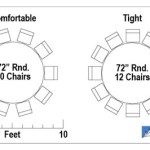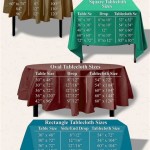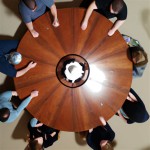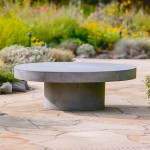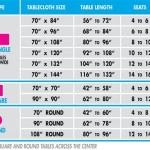Tablecloth Size Guide for a 10-Seater Rectangular Table
Selecting the correct tablecloth size for a 10-seater rectangular table is crucial for both aesthetic appeal and practical functionality. A well-chosen tablecloth enhances the dining experience, protects the table surface, and complements the overall décor of the room. Determining the appropriate dimensions involves considering the table's existing measurements and the desired drop, which is the length the tablecloth hangs over the edges of the table.
This article provides a comprehensive guide to choosing the right tablecloth size for a 10-seater rectangular table. It will explore the factors influencing the decision, common sizing conventions, methods for calculating the ideal dimensions, and different types of tablecloths suitable for such large tables. Additionally, it will address considerations for special occasions and provide tips for maintaining the tablecloth's integrity and appearance over time.
Understanding Tablecloth Drop and Table Dimensions
The "drop" refers to the amount of fabric that drapes over the edge of the table. A standard drop ranges from 6 to 12 inches, but the optimal drop depends on the desired look and formality of the setting. A shorter drop (6-8 inches) is often preferred for casual settings, while a longer drop (10-12 inches) is generally chosen for more formal occasions. A drop exceeding 12 inches can be cumbersome and may interfere with guests' comfort.
To determine the ideal tablecloth size, the table's length and width must be accurately measured. Use a measuring tape to find the table's dimensions, ensuring to measure the longest and widest points. Record these measurements in inches or centimeters for accurate calculations. In the context of a 10-seater rectangular table, common dimensions are typically between 96 to 120 inches in length and 40 to 48 inches in width. Note that these measurements can vary, so precisely measuring the table is always recommended.
For example, if a rectangular table measures 108 inches long and 44 inches wide, and a 10-inch drop is desired, the calculation would be as follows: For the length, add twice the drop to the table's length (10 inches x 2 = 20 inches), then add that number to the original length measurement (108 inches + 20 inches = 128 inches total). For the width, similarly add twice the drop to the table's width (10 inches x 2 = 20 inches), then add that number to the original width measurement (44 inches + 20 inches = 64 inches total). Thus, in this case, a tablecloth with dimensions of at least 128 inches long and 64 inches wide would be needed to cover the table with a 10-inch drop.
Calculating the Ideal Tablecloth Size
The process for calculating the ideal tablecloth size involves adding the desired drop measurement to each dimension of the table (length and width). The formula is straightforward: Tablecloth Length = Table Length + (2 x Desired Drop) and Tablecloth Width = Table Width + (2 x Desired Drop). This calculation ensures that the tablecloth hangs evenly on all sides of the table.
Consider a scenario where a 10-seater rectangular table measures 100 inches in length and 42 inches in width. If the desired drop is 8 inches, the calculation would be: Tablecloth Length = 100 inches + (2 x 8 inches) = 116 inches and Tablecloth Width = 42 inches + (2 x 8 inches) = 58 inches. Therefore, a tablecloth measuring 116 inches long and 58 inches wide would provide the desired 8-inch drop on all sides of the table.
In situations where a custom drop is preferred, this calculation is adaptable. For instance, if a host desires a 12-inch drop for a formal event, the same formula applies, simply replacing the 8-inch drop with a 12-inch drop. It is crucial to measure accurately and consistently to achieve the desired fit. Should there be any unevenness in the table's surface or shape, averaging measurements or consulting with a tailor or linen specialist can assist in achieving a more precise fit.
Material Considerations and Tablecloth Types
The choice of tablecloth material significantly influences its appearance, durability, and ease of care. Common materials include linen, cotton, polyester, and blends thereof. Linen is a classic choice, known for its elegant drape and luxurious feel, but it tends to wrinkle easily and requires more careful maintenance. Cotton is a versatile and affordable option, offering good absorbency and durability, but it is also prone to wrinkling. Polyester is a synthetic fabric favored for its stain resistance, durability, and ease of care, making it a practical choice for frequent use. Blends of these materials can offer a balance of desirable properties, such as the softness of cotton combined with the wrinkle resistance of polyester.
Several types of tablecloths are well-suited for 10-seater rectangular tables. Traditional rectangular tablecloths are the most common choice, providing full coverage and a classic look. Overlay tablecloths, typically smaller in size, can be layered over a larger tablecloth to add texture, color, or pattern. Table runners, which run lengthwise down the center of the table, can be used in conjunction with placemats to create a more decorative and less formal setting. Additionally, fitted tablecloths, which have elasticized edges that grip the table, offer a secure and wrinkle-free fit, but they may not be suitable for all table shapes or sizes.
The selection of material and type depends on the occasion, the desired aesthetic, and the level of maintenance preferred. For formal events, linen or high-quality cotton tablecloths are often chosen for their elegant appearance. For casual gatherings or outdoor settings, polyester or blended fabrics are more practical due to their durability and ease of care. Color and pattern choices should complement the existing décor and tableware.
Beyond these conventional choices, the market offers specialized tablecloth solutions catering to specific needs. These include waterproof tablecloths for outdoor dining, stain-resistant tablecloths for homes with children or frequent spills, and heat-resistant tablecloths for buffet setups. These specialized options, however, may require more in-depth evaluation to ascertain their suitability for a specific event. Some may come in limited sizes, thus requiring custom tailoring to match the requirements for a 10-seater rectangular table.
Special Occasions and Customization
For special occasions, such as weddings, holidays, or formal dinners, the tablecloth plays a crucial role in setting the ambiance. Opting for higher-quality materials, intricate patterns, or embellishments like lace or embroidery can elevate the table setting. The desired drop may also be adjusted to create a more dramatic effect, with longer drops being favored for formal events. Consider the overall theme and color scheme of the event when selecting the tablecloth.
Custom-made tablecloths offer the opportunity to achieve a perfect fit and personalize the design. This option is particularly useful for tables with unusual dimensions or for those seeking unique patterns or materials. Working with a tailor or linen specialist allows for precise measurements and the selection of fabrics that meet specific requirements. Customization extends beyond size to include details like hem finishes, corner treatments, and the addition of monograms or logos.
When planning for an event, consider the practical aspects of the tablecloth as well. Stain resistance is a valuable feature, especially when serving food and beverages that are likely to spill. Wrinkle resistance can also save time and effort in preparation. Additionally, consider the ease of cleaning and maintenance, as some materials may require professional laundering.
Furthermore, for themed events, custom printing can add a personal touch by incorporating event-specific motifs, logos, or color schemes. This can contribute significantly to the overall aesthetic and create a memorable dining experience. However, the cost of custom-made tablecloths, especially those with intricate designs or embellishments, can be significantly higher than standard options, necessitating careful budgeting.
Maintenance and Care Tips
Proper maintenance and care are essential for preserving the appearance and longevity of a tablecloth. Follow the manufacturer's instructions for washing and drying, as different materials require different care techniques. Generally, linen and cotton tablecloths should be washed in cold water and tumble-dried on low heat to prevent shrinkage and fading. Polyester tablecloths are more durable and can typically be washed in warm water and tumble-dried on medium heat.
Stains should be treated promptly to prevent them from setting. Blot the stain with a clean cloth or paper towel and apply a stain remover appropriate for the material. Avoid rubbing the stain, as this can spread it and damage the fabric. For stubborn stains, consider soaking the tablecloth in a solution of water and mild detergent before washing.
Ironing is often necessary to remove wrinkles and create a smooth, polished look. Iron linen and cotton tablecloths while they are still slightly damp, using a medium heat setting. Polyester tablecloths typically require minimal ironing, and some may not need ironing at all. Store tablecloths in a cool, dry place, away from direct sunlight, to prevent fading and discoloration. Folding them neatly or rolling them on a cardboard tube can help prevent creases.
In addition to these general guidelines, there are specific measures to take for specific materials. For instance, linen fabric benefits from gentle handling and should be stored in breathable cotton bags to prevent moisture buildup. Silk tablecloths, on the other hand, typically require professional dry cleaning to maintain their luster and texture. Regularly inspecting the tablecloth for wear and tear, such as frayed edges or loose threads, is also advisable. Promptly addressing these issues can prevent further damage and prolong the tablecloth’s lifespan.

7 Tablecloth Information Ideas Table Cloth Sizes How To Plan

Tablecloth Size Chart Asap Linen

Use This Tablecloth Size Chart For Perfect Party Planning Lovetoknow

Urby 90 X 156 Inch Polyester Rectangular Table Cloth For 8 10 Foot That Seats 12 Person Fits Extra Long Tables Or Cut To Fit Smaller

Tablecloths For Rectangle Tables Cotton Linen Table Cloth Waterproof Tablecloth Wrinkle Free Farmhouse Dining Cover Soft Fabric Cloths

Tablecloth Size Chart Guide Cyruscrafts

What Size Tablecloth Do I Need Deconovo Us

Tablecloth Size Guide Table Linen Hire Tips Plato Catering

Urby 90 X 156 Inch Polyester Rectangular Table Cloth For 8 10 Foot That Seats 12 Person Fits Extra Long Tables Or Cut To Fit Smaller

Tablecloth Sizes Ilrated Charts Guide
Related Posts

